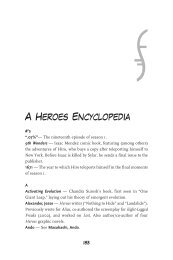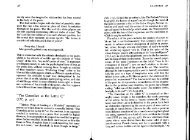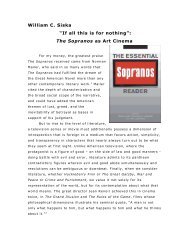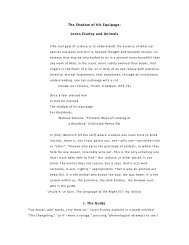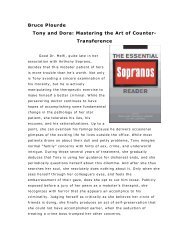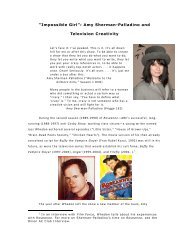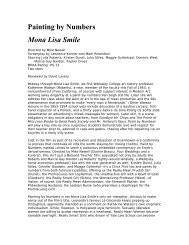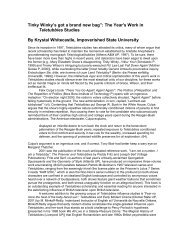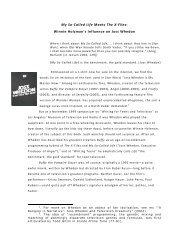Melville's Moby‐Dick and Hollywood Adapting Moby ... - David Lavery
Melville's Moby‐Dick and Hollywood Adapting Moby ... - David Lavery
Melville's Moby‐Dick and Hollywood Adapting Moby ... - David Lavery
You also want an ePaper? Increase the reach of your titles
YUMPU automatically turns print PDFs into web optimized ePapers that Google loves.
<br />
<br />
Melville’s <strong><strong>Moby</strong>‐Dick</strong> <strong>and</strong> <strong>Hollywood</strong> <br />
Investigating the “erotics of reading” in The Pleasure of <br />
the Text (1975), Rol<strong>and</strong> Barthes once pondered why “we do <br />
not read everything with the same intensity of reading,” why <br />
“our very avidity for knowledge impels us to skim or to skip <br />
certain passages (anticipated as ‘boring’) . . . (no one is <br />
watching) descriptions, explanations, analyses, <br />
conversations.” Of course, no author, Barthes concedes, can <br />
predict in advance what will be skipped: <br />
<br />
he cannot choose to write what will not be read. And yet, it is <br />
the very rhythm of what is read <strong>and</strong> what is not read that creates the pleasure <br />
of the great narratives: has anyone ever read Proust, Balzac, War <strong>and</strong> Peace, <br />
word for word? (Proust’s good fortune: from one reading to the next, we never <br />
skip the same passages.)1 1 <br />
Certainly, no two readers of <strong><strong>Moby</strong>‐Dick</strong> (1851), nor the same reader reading <br />
subsequently, nor two screenwriters preparing, forty years apart, to adapt the classic <br />
novel by Herman Melville (1819–91) for the film medium, skip the same passages or <br />
discover the same text. <strong><strong>Moby</strong>‐Dick</strong>, after all, is full‐to‐overflowing with <br />
“descriptions, explanations, analyses, conversations” inviting anything but the avid, <br />
easily bored student, the supposedly disinterested but often with an ax‐to‐grind <br />
scholar, <strong>and</strong> the medium‐determined <strong>and</strong> cost‐driven screenwriter to pass on by. But <br />
it is by no means certain, as with Remembrance of Things Past, that Melville’s text <br />
has been the beneficiary of these lapses. There are few <br />
great books more often misread or maladapted. <br />
<br />
<strong>Adapting</strong> <strong><strong>Moby</strong>‐Dick</strong> <br />
Soon after the release of The Scarlet Letter (Rol<strong>and</strong> <br />
Joffe ́, 1995), a film featuring Demi Moore as Hester <br />
Prynne that perverted Nathaniel Hawthorne’s original <br />
novel by supplying a happy ending, a cartoon appeared in <br />
1 Rol<strong>and</strong> Barthes, The Pleasure of the Text, trans. Richard Miller (New<br />
York: Hill <strong>and</strong> Wang, 1975), pp. 10–11; italics in original.
The Collected Works of <strong>David</strong> <strong>Lavery</strong> 2<br />
the New Yorker that speculated on what might happen if she were to star in a new <br />
version of another classic novel of the American Renaissance. Over a caption which <br />
reads “Demi Moore’s <strong>Moby</strong> Dick,” we see the actress st<strong>and</strong>ing, like a competitor at a <br />
fishing contest, beside her prize catch: a giant, dead, white whale, hanging from a <br />
hook. So far, the Moore version of Melville’s classic novel <strong><strong>Moby</strong>‐Dick</strong> (1851) has not <br />
yet been made, but we need not wait for a movie <strong><strong>Moby</strong>‐Dick</strong> with a happy ending. <br />
Two early twentieth‐century incarnations of Melville’s book, both from Warner <br />
Brothers, the silent Sea Beast (Millard Webb, 1926) <strong>and</strong> the talkie <strong>Moby</strong> Dick (Lloyd <br />
Bacon, 1930) – both starring John Barrymore as “Captain Ahab Ceely” – had Ahab <br />
vanquishing the whale <strong>and</strong> living to tell about it. Both even added a love story, with <br />
Ahab battling his half‐brother Derek (George O’Hara, Lloyd Hughes) for his fiance ́ e, <br />
Esther Harper (Dolores Costello) in the first, Faith <br />
Mapple (Joan Bennett) in the second. In both films <br />
Ahab loses his leg to the whale after being pushed <br />
overboard by the scheming Derek <strong>and</strong> seeks revenge <br />
against the beast who, he fears, has ruined his <br />
marriage prospects. In both <br />
Ahab not only slaughters <br />
his watery nemesis but <br />
returns from his <br />
mission to murder <br />
Derek <strong>and</strong> get the <br />
girl. 2 <br />
In two later, more authentic adaptations of <br />
<strong><strong>Moby</strong>‐Dick</strong>, a 1956 version (again from Warner <br />
Brothers) directed by John Huston from a screen‐play by <br />
the science fiction writer Ray Bradbury, <strong>and</strong> a 1998 Hallmark Hall of Fame/USA <br />
Network made‐for‐television production directed by Franc Roddam, Ahab’s battle <br />
with the whale is finally fatal, <strong>and</strong> neither includes a love story. But neither do these <br />
more superficially faithful <strong>and</strong> ambitious films make the slightest attempt to render <br />
Ishmael as the novel’s central intelligence, nor capture even a trace of the book’s <br />
wicked, often blasphemous humor, nor fully engage Melville’s complex metaphors. <br />
2 I should note that I have not been able to screen either of these<br />
early versions of <strong>Moby</strong>-Dick <strong>and</strong> am indebted to Cahir’s <strong>and</strong> Tibbetts’s<br />
account of the films for my comments here. Their bad-faith distortions make<br />
them mainly of historical interest anyway.
The Collected Works of <strong>David</strong> <strong>Lavery</strong> 3<br />
The literary critic Charles Feidelson was perhaps thinking of decades of often <br />
uncomprehending literary readings of <strong><strong>Moby</strong>‐Dick</strong> when he insisted that “Certainly no <br />
interpretation is adequate which fails to take into account the multiplicity of <br />
possible meanings in the white whale <strong>and</strong> in <strong><strong>Moby</strong>‐Dick</strong> as a whole.” 3 If the same <br />
st<strong>and</strong>ard is applied to film “interpretations,” both of the latter twentieth‐century <br />
film adaptations of <strong><strong>Moby</strong>‐Dick</strong>, the focus of my attention here, must be judged <br />
failures. One of the greatest of all novels still awaits a film version that captures <br />
Melville’s novel in all its intricacy. <br />
<br />
<strong>Moby</strong> Dick (1956) <br />
Speaking of his then recently completed <strong>Moby</strong> Dick to the film critic Arthur <br />
Knight, John Huston would recall that “Ray [Bradbury] <strong>and</strong> I tried to be as faithful to <br />
the meaning of the book as our own underst<strong>and</strong>ing <strong>and</strong> the special dem<strong>and</strong>s of the <br />
movie medium would allow.” 4 Taking the director at his word, we might well <br />
conclude, given the film they produced, that both their <br />
comprehension of the novel <strong>and</strong> their vision of the <br />
possibilities of cinema were imperfect <strong>and</strong> limited. <br />
Huston, then an internationally known director of such <br />
films as The Maltese Falcon (1941), Key Largo (1948), The <br />
Treasure of the Sierra Madre (1948), The Asphalt Jungle <br />
(1950), The African Queen (1951), <strong>and</strong> The Red Badge of <br />
Courage (1951), with a penchant for adapting literary works <br />
<strong>and</strong> a larger‐than‐life personality, had been contemplating filming <strong><strong>Moby</strong>‐Dick</strong> since <br />
the early 1940s. He initially hoped to cast his father Walter Huston as Ahab. When he <br />
finally secured the funding to make the film in the mid‐1950s <strong>and</strong> cast the usually <br />
mild‐mannered Gregory Peck as the monomaniacal Ahab, 5 he invited Bradbury, then <br />
3 Charles Feidelson, quoted in Br<strong>and</strong>on French, “Lost at Sea,” in Gerald<br />
Peary <strong>and</strong> Roger Shatzkin, eds., The Classic American Novel <strong>and</strong> the Movies<br />
(New York: Ungar, 1977), p. 54. Further quotations from French will be cited<br />
parenthetically in the text.<br />
4 Arthur Knight, “The Director,” Saturday Review, June 9, 1956, p. 29.<br />
5 As Scott Hammen observes, responding to the wishful thinking of<br />
those critics of Peck’s performance that Huston had made <strong>Moby</strong> Dick a family<br />
affair, “if Huston had shot <strong>Moby</strong> Dick before his father’s death [1950], he<br />
would have done it at a time when he was under strict studio supervision <strong>and</strong><br />
not a freewheeling international celebrity, able to marshal the resources of<br />
m any nations to his personal ends” (Hammen, John Huston [New York:<br />
Twayne, 1985], pp. 77–78). Peck’s performance was often singled out by<br />
critics as the film’s weakest link, <strong>and</strong> the influential auteurist critic Andrew<br />
Sarris would suggest that Huston himself should have played the part, with
The Collected Works of <strong>David</strong> <strong>Lavery</strong> 4<br />
in his thirties, whose work, especially The Martian Chronicles (1950), he admired, to <br />
try his h<strong>and</strong> at writing the script. Huston, Bradbury would recall in self‐<br />
congratulatory fashion, saw “the poet in my writing” (Atkins “An Interview,” 44). 6 <br />
Bradbury claimed never to have read <strong><strong>Moby</strong>‐Dick</strong> before accepting Huston’s <br />
assignment, but under contract he would read <strong>and</strong> reread the book <strong>and</strong> turn out (by <br />
his own estimation) more than 1,200 pages of outlines <strong>and</strong> text in the process of <br />
generating 140 pages of screenplay (Atkins “An Interview,” 51). During a sojourn in <br />
London during the run‐up to filming – at nearby Elstree Studios, in Wales, Irel<strong>and</strong>, <br />
<strong>and</strong> off the coast of Portugal – Bradbury even convinced himself that he was <br />
channeling <strong><strong>Moby</strong>‐Dick</strong>’s author: “I am Herman Melville,” he began to feel. “The ghost <br />
of Melville was in me” (46). Bradbury persuaded himself as well that the changes he <br />
made in Melville’s narrative would have been enthusiastically approved by the <br />
author (47). <br />
<br />
With Huston’s wholehearted approval (44), Bradbury <br />
decided to leave out the mysterious Fedallah <strong>and</strong> his infernal <br />
crew entirely. “He’s a bore,” Bradbury concluded. “He’s <br />
horrible. He’s the thing that ruins the whole book. I don’t <br />
care what the Melville scholars say, he’s the extra mystical <br />
symbol which breaks the whale’s back, <strong>and</strong> he would be <br />
unbearable on the screen” (44) He inserted early glimpses of <br />
Stubb <strong>and</strong> Flask <strong>and</strong> even Ahab, melodramatically lit by a <br />
lightning flash, during the arrival of Ishmael (a bl<strong>and</strong> <strong>and</strong> unengaging Richard <br />
Basehart) at the Spouter Inn. He combined Chapters 28 <strong>and</strong> 36 (“Ahab,” “The <br />
Quarter‐Deck: Ahab <strong>and</strong> All”) in his version of Ahab’s first appearance on The <br />
Pequod, fusing Ishmael’s <strong>and</strong> the crew’s first glimpse of their captain as “a man cut <br />
away from the stake, when the fire has overrunningly wasted all the limbs without <br />
consuming them, or taking away one particle from their compacted aged robustness” 7 <br />
Orson Welles, who has a small but significant role in the film as Father<br />
Mapple, directing (cited by Thomas Atkins, “An Interview with Ray Bradbury,”<br />
in Gerald Peary <strong>and</strong> Roger Shatz- kin, eds. The Classic American Novel <strong>and</strong><br />
the Movies (New York: Ungar, 1977), p. 3. Further quotations from Atkins will<br />
be cited parenthetically in the text.<br />
6 Bradbury <strong>and</strong> Huston would later battle over Huston’s request for a<br />
screen- writing credit, Bradbury insisting that the director contributed<br />
nothing. The Screen Writers Guild found on behalf of Huston.<br />
7 Herman Melville, <strong>Moby</strong>-Dick, ed. Hershel Parker <strong>and</strong> Harrison Hayford,<br />
2nd edn, Norton Critical Edition (New York: W. W. Norton, 2002), p. 108.<br />
Further quotations will be cited parenthetically in the text.
The Collected Works of <strong>David</strong> <strong>Lavery</strong> 5<br />
with his initial stratagems (nailing the gold ounce to the mast; asking the crew to <br />
splice h<strong>and</strong>s; crossing the lances) for entangling them in his quest, but delaying for a <br />
later scene below decks in Ahab’s cabin his very public explanation to the skeptical <br />
Starbuck of “the little lower layer” (Chapter 36), the deeper, epistemological reasons <br />
for his vengeance. <br />
Bradbury changed, too, the order of several key events, the better to enhance <br />
the drama, or so he thought. He moved the encounter with the British ship the <br />
Samuel Enderbey <strong>and</strong> its Captain Boomer, who remains jovial despite losing his arm <br />
to <strong>Moby</strong> Dick, from the final third of the novel (“Leg <strong>and</strong> Arm,” Chapter 100) to the <br />
first hour of the movie <strong>and</strong> making Boomer sillier than in the book. He delayed <br />
Ahab’s confrontation with the “clear spirit” of a storm at sea <strong>and</strong> his “I blow out the <br />
last fear” taming of the St. Elmo’s Fire (“The C<strong>and</strong>les,” Chapter 119) until after his <br />
refusal to aid the captain of The Rachel’s hunt for his lost son (“The Pequod Meets <br />
The Rachel,” Chapter 128). <br />
Queequeg’s realization of his coming death likewise departs substantially from <br />
the novel. Melville has the harpooner fall ill from a mysterious fever, which leads <br />
him to order the carpenter to prepare a coffin. When his fever breaks, his <br />
resignation ends as well. In the Bradbury version he reads the signs of his death <br />
while casting his bones, orders a coffin made, gives all his worldly possessions to <br />
Ishmael, <strong>and</strong> becomes a living statue, roused from his deathwatch only when his <br />
bosom friend’s life is threatened. <br />
Bradbury inexplicably recasts the ending as <br />
well, having First Mate Starbuck decide to pursue <br />
<strong>Moby</strong> Dick even after the Captain’s death. <br />
According to French, Bradbury’s original screenplay <br />
even had Starbuck taking up Ahab’s pursuit <strong>and</strong> <br />
killing the whale: “the most disturbing adaptative <br />
change,” French argues, “is that Starbuck in the <br />
movie actually succeeds in killing <strong>Moby</strong> Dick. (The <br />
black blood in the film <strong>and</strong> a reference in the script <br />
to ‘the dying whale’ confirm the murder.) One <br />
can’t kill the phantom of life in the novel, but evidently in Bradbury’s estimation, <br />
<strong>Moby</strong> Dick was, after all, just a whale” (French, “Lost at Sea,” 61). 8 <br />
8 Although French may well be right about the wording in the script,<br />
which she had evidently examined first h<strong>and</strong>, I see no evidence whatsoever in
The Collected Works of <strong>David</strong> <strong>Lavery</strong> 6<br />
Bradbury also had Ahab, entangled in harpoon lines, go down with the whale – <br />
an idea which, more than any other, convinced him that Melville was his co‐pilot. 9 <br />
(This change, in turn, required a reformulation of Elijah’s prophecy to Ishmael <strong>and</strong> <br />
Queequeg earlier in the story so that it would be properly self‐fulfilling.) But <br />
Bradbury’s “inspiration” was clearly, as Linda Costanzo Cahir <strong>and</strong> John C. Tibbetts <br />
hint (154), a case of what is now sometimes called “cryptonesia,” a cl<strong>and</strong>estine <br />
creative theft, conveniently forgotten. 10 We need not look far to discover the source <br />
of Bradbury’s scripted end for Ahab. In “The Chase – Third Day” (Chapter 135), the <br />
missing Fedallah – the character that Bradbury conveniently threw overboard – is <br />
found in a similar prophecy‐fulfilling pose: <br />
<br />
<br />
at that moment a quick cry went up. Lashed round <strong>and</strong> round to the fish’s back; <br />
pinioned in the turns upon turns in which, during the past night, the whale had <br />
reeled the involutions of the lines around him, the half torn body of the Parsee <br />
was seen; his sable raiment frayed to shreds; his distended eyes turned full <br />
upon old Ahab. (433) <br />
Inspiration indeed. <br />
“It’s a pretty good blend,” Bradbury would conclude after viewing the film <br />
that Huston made from his first screenplay: “It almost worked. The film is almost <br />
magnificent” (Atkins, “An Interview,” 50). An exaggeration, no doubt, but the film <br />
does get many things right. Orson Welles’s performance as Father Mapple, minister <br />
to the whaling industry, who sermonizes on Jonah from a pulpit in the shape of a <br />
ship’s prow accessible only by a rope ladder, could not be improved upon. The <br />
whaling scenes, combining studio work with actual whaling footage, are often quite <br />
gripping. Harry Andrews is completely convincing as “I know not all that may be <br />
coming, but be it what it will, I’ll go to it laughing” Second Mate Stubb. The opening <br />
credit sequence, utilizing contemporary paintings of whaling scenes; the film’s <br />
emphatic score, composed by Philip Sainton; its innovative cinematography (by <br />
the film itself that <strong>Moby</strong> Dick has been killed.<br />
9 “I ran half way across London to Huston’s hotel <strong>and</strong> I threw the script<br />
[with the new ending] at him. I said, ‘There. I think that’s it.’ And he read it<br />
<strong>and</strong> said, ‘Jesus Christ, Ray! This is it. This is the way we’ll shoot the<br />
ending’” (Atkins, “An Interview,” p. 46).<br />
10 Linda Costanzo Cahir <strong>and</strong> John C. Tibbetts, “<strong>Moby</strong>-Dick (1851),” in<br />
John C. Tibbetts <strong>and</strong> James M. Welsh., eds., Novels into Film: The<br />
Encyclopedia of Movies Adapted from Books (New York: Checkmark Books,<br />
1999), p. 154.
The Collected Works of <strong>David</strong> <strong>Lavery</strong> 7<br />
Oswald Morris) that fused Technicolor <strong>and</strong> black‐<strong>and</strong>‐white prints of the same shot – <br />
all these factors succeed splendidly in establishing tone <strong>and</strong> mood <strong>and</strong> atmosphere. <br />
“Our biggest problem,” Huston would recall, “was to turn Melville’s <br />
expositional passages into characteristic dialogue.” 11 Bradbury would, in turn, <br />
characterize the challenge the filmmakers faced as a fusion of “the Shakespearean <br />
approach which is sheer language <strong>and</strong> the cinematic approach which is pure image” <br />
(50). Much was lost in the process. As French argues, the film eliminated “most of <br />
the documentary (whaling as a commercial occupation) <strong>and</strong> the philosophical <br />
dimensions,” 12 <strong>and</strong> “these deletions cut the story loose from its moorings as ‘the real <br />
living experience of living men’ in Ishmael’s words” (French, “Lost at Sea,” 53; <br />
Ishmael’s words are from <strong>Moby</strong> Dick,” Chapter 41). <br />
<br />
<strong>Moby</strong> Dick (1998) <br />
Directed by Franc Roddam (Quadrophenia <br />
[1979], The Lords of Discipline [1983], K2 [1992], <br />
Cleopatra [1999]) from a screenplay he co‐authored <br />
with Anton Diether (Night Games [1980], Cleopatra <br />
[1999]), the television version of <strong>Moby</strong> Dick was <br />
filmed in Australia at an air force base near <br />
1998 <strong>Moby</strong> Dick remains an uninspired disappointment. <br />
Melbourne <strong>and</strong> off the coast. Although graced, <br />
thanks to its broadcast format, with an extra hour <br />
of narrative time in which to render Melville’s <br />
200,000‐plus word novel (the film was aired as a <br />
three‐part mini‐series) <strong>and</strong> the beneficiary of more <br />
than forty years of advances in cinematic art <strong>and</strong> <br />
science since the Huston/Bradbury version, the <br />
As “‘Thar She Blows!’ The Making of <strong>Moby</strong> Dick,” a behind‐the‐scenes video <br />
included on the DVD of the 1998 version, makes abundantly clear, the filmmakers <br />
behind the most recent attempt to get the story of Ahab <strong>and</strong> the white whale right <br />
were driven by high ambitions. Patrick Stewart, best known at the time for his role as <br />
11 Knight, “The Director,” p. 29.<br />
12 As French observes, “whether <strong>Moby</strong> Dick is good or evil is not clear<br />
in the film any more than it is in the novel. The difference is that this<br />
ambiguity is largely ignored as unimportant in the movie, whereas it is the<br />
central focus of the novel” (“Lost at Sea,” p. 54).
The Collected Works of <strong>David</strong> <strong>Lavery</strong> 8<br />
another captain (Jean‐Luc Picard on Star Trek: The Next Generation) <strong>and</strong>, later, as <br />
Professor Charles Xavier in The X‐Men franchise, spent eight months immersed in the <br />
world of Herman Melville preparing for the “role of a lifetime” as Ahab. Piripi <br />
Waretini, the Maori who plays Queequeg as part of the film’s more international, <br />
more multiethnic cast, wrote his M. A. thesis on Melville. Those responsible for what <br />
the narration calls the film’s “state of the art” special effects <strong>and</strong> “totally believable <br />
whales” reveal the secrets of their trade. Peck, who narrates the documentary <strong>and</strong> <br />
turns in a unmemorable performance as Father Mapple in the film, insists that this <br />
new version, unlike the one in which he himself starred, is more faithful to both <br />
Melville’s philosophy <strong>and</strong> his “great Victorian rolling prose.” Despite such <br />
pretensions, it would be difficult to argue that the film that resulted is a pronounced <br />
improvement in any respect. <br />
Closer in age than Peck to Ahab <strong>and</strong> suitably scarred <strong>and</strong> wizened, 13 Stewart is <br />
certainly adequate as The Pequod’s captain, yet he never succeeds in convincing us <br />
of the character’s high purpose, his proximity to madness, or his power to exercise <br />
his will over the crew. In response to contemporary criticism of Peck’s performance <br />
in his film, Huston had insisted that the “next generation will appreciate it more than <br />
the last.” 14 Stewart’s understated but hardly exemplary turn helps to confirm <br />
Huston’s prediction: his Ahab only enhances our estimate of Peck’s work. <br />
Once again, Ishmael, played this time by Henry Thomas, sixteen years after <br />
starring in Spielberg’s ET (1982), is barely developed as a character. On “‘Thar She <br />
Blows!’” director Roddam insists that the film is really all about his journey, his great <br />
adventure, his learning, but in fact he is, from beginning to end, a humorless, dull, <br />
pessimistic cipher. 15 As in the 1956 film, we learn almost nothing about him; we are <br />
seldom invited to see the wonders of whaling through his eyes. The filmmakers <br />
choose instead to devote a sizable portion of their additional time to Ishmael <strong>and</strong> <br />
Queequeg’s relationship, now reduced to buddy film clichés, <strong>and</strong> to Ishmael’s <br />
initiation as a “new pup” sailor. We must endure several scenes of the novice’s <br />
hazing by his shipmates (pouring grog over his blistered h<strong>and</strong>s, for example). As both <br />
the novel <strong>and</strong> the Huston/Bradbury version make clear, Ishmael is a veteran sailor, <br />
though not an experienced whaler; Roddam <strong>and</strong> Diether make him a neophyte, <br />
13 The book suggests that Ahab is in his late fifties, as was Stewart<br />
(born 1940) at the time of filming. Peck (1917–2003) was only forty when he<br />
played the role for Huston.<br />
14 John Huston, An Open Book (Boston: Knopf, 1980), p. 258.<br />
15 “‘Thar She Blows!’: The Making of <strong>Moby</strong> Dick,” written <strong>and</strong> produced<br />
by Russ Patrick, <strong>Moby</strong> Dick DVD, Hallmark Home Entertainment, 1998.
completely “at sea,” all the better to abuse him. <br />
The Collected Works of <strong>David</strong> <strong>Lavery</strong> 9<br />
Roddam <strong>and</strong> Diether take other liberties. Elijah (Bruce Spence) is made at <br />
once more prominent – we see him stalking Ishmael upon his first arrival in New <br />
Bedford – <strong>and</strong> less ominous: more a crazy street person than a mad prophet. The <br />
Spouter Inn is populated with prostitutes; Stubb (Hugh Keays‐Byrne) is seen exiting <br />
with two in tow. (In a continuity error, Ishmael will soon run into Stubb <strong>and</strong> his <br />
women again in an upstairs hall.) Precious time is frittered away transforming <strong>Moby</strong>‐<br />
Dick into Mutiny on the Bounty: both Starbuck ( Ted Levine) <strong>and</strong> the crew <br />
contemplate a hostile takeover of the ship, <strong>and</strong> at one point Ahab puts an end to <br />
such plotting with a rifle. While being more politically correct in casting Queequeg <br />
(Huston, after all, had used his Austrian friend Frederick Ledebur), Roddam <strong>and</strong> <br />
Diether rob him of nearly every ounce of dignity, having him behave more like a <br />
Polynesian party animal than a prince <strong>and</strong> giving him a full head of hair (he is bald in <br />
the novel). They take Perth, in the book the ship’s blacksmith <strong>and</strong> an interesting <br />
minor character whom Ahab subjects to philosophical monologues, <strong>and</strong> transform <br />
him into a rowdy, grog‐loving sailor who falls to his death off the rigging. In this <br />
version of <strong><strong>Moby</strong>‐Dick</strong>, the enigmatic Bulkington, whose willingness to put to sea <br />
again almost immediately after his last voyage perplexes Ishmael (“The Lee Shore,” <br />
Chapter 23), inexplicably steals one of the ship’s invaluable long boats <strong>and</strong> takes off <br />
for home <strong>and</strong> family – with Starbuck’s permission! <br />
Starbuck, himself, as played by Levine, best known as the serial killer in <br />
Silence of the Lambs (1991), is both more conspiratorial – he is convinced that Ahab <br />
has sold his soul to Satan <strong>and</strong> is guilty of the crime of “usurpation” – <strong>and</strong> <br />
antagonistic. Roddam <strong>and</strong> Diether even have Ishmael <strong>and</strong> Starbuck sit down for a <br />
preposterous heart‐to‐heart about the fate of the ship. In the end, they have the <br />
First Mate stay behind with The Pequod during the final pursuit of <strong><strong>Moby</strong>‐Dick</strong>, <strong>and</strong> <br />
the ship goes to the bottom after being consumed in a fire, not sucked below, as it is <br />
in both the novel <strong>and</strong> the Huston/Bradbury version, in the whirlpool of the white <br />
whale’s wake. <br />
Like the Huston/Bradbury version, this <strong>Moby</strong> Dick also alters the ends of both <br />
Queequeg <strong>and</strong> Ahab. This time Queequeg’s resignation to his own death follows <br />
Ahab’s refusal to assist The Rachel. Disavowing his Captain’s obsession, he is tied, <br />
catatonic, to the mast <strong>and</strong> nearly washed overboard in the storm scene (from <br />
“C<strong>and</strong>les”), coming back to life after Ahab tames the St. Elmo’s Fire, groveling at his <br />
feet, <strong>and</strong> proclaiming him his god. Ahab’s demise owes more to the 1956 film than to
The Collected Works of <strong>David</strong> <strong>Lavery</strong> 10<br />
the novel. Indeed, Roddam <strong>and</strong> Diether must have been impressed with Bradbury’s <br />
alternate ending, for they, too, have Ahab die entangled in harpoon lines <strong>and</strong> <br />
drowned by his nemesis, though this time Ahab later floats free. <br />
To its credit, the Hallmark version does offer us in an early scene a glimpse of <br />
Ahab’s briefly mentioned young wife <strong>and</strong> child (“The Ship,” Chapter 16); does restore <br />
Fedallah <strong>and</strong> his men to the crew of The Pequod; does cast Pip, Ahab’s black cabin <br />
boy, overboard (“The Castaway,” Chapter 93) <strong>and</strong> show his later madness. It even <br />
includes a taste of some of Ahab’s Shakespearean speeches: his “swerve me” railing <br />
at the gods (“Swerve me? Ye cannot swerve me, else ye swerve yourselves!” <br />
[“Sunset,” Chapter 37]), for example; <strong>and</strong> Ahab’s description, in conversation with <br />
the carpenter, of the perfect man (“fifty feet high in his socks . . . a quarter of an <br />
acre of fine brains . . . a sky‐light on top of his head to illuminate inwards” [“Ahab <br />
<strong>and</strong> the Carpenter,” Chapter 108]). Despite the claims of superiority on “‘Thar She <br />
Blows!,’” the whaling scenes, however, are especially unsatisfactory. 16 Every time we <br />
see a “whale” when a harpoon or lance pierces it <strong>and</strong> unconvincing blood spews, we <br />
are immediately aware of the artifice. Whether it is the faux whale models we watch <br />
or the CGI <strong>Moby</strong> Dick who breaches Fedallah’s boat before crushing it <strong>and</strong> smashing <br />
into The Pequod, we are never for a moment able to suspend our disbelief. <br />
<br />
The Unmade <strong><strong>Moby</strong>‐Dick</strong> <br />
Will there ever be a faithful movie version of <strong><strong>Moby</strong>‐Dick</strong>? Putting aside the <br />
obvious, <strong>and</strong> perhaps grave, problem of the commercial viability of such a film, we <br />
can nevertheless stipulate some essential prerequisites. <br />
It must be humorous. Although many readers, including Bradbury <strong>and</strong> Roddam <br />
<strong>and</strong> Diether, seem oblivious to Melville’s sense of humor, the book is in fact filled <br />
with hilarious, often scatological, sometimes sacrilegious, comic touches never <br />
capitalized on by either the 1956 or 1998 films. The ideal movie <strong><strong>Moby</strong>‐Dick</strong> might <br />
focus greater attention on the “marriage” of the “cosy loving pair,” Ishmael <strong>and</strong> <br />
Queequeg, with which Melville has a great deal of fun (“A Bosom Friend,” Chapter <br />
10). It would not spare us, as both films do, any knowledge of the flatulence of our <br />
fellow mammal the whale, hilariously depicted in ”The Pequod Meets The Virgin,” <br />
(Chapter 81). It might even want to include some reference to Ishmael’s discussion, <br />
in one of those cetology chapters (“The Cassock,” Chapter 95) that students <strong>and</strong> <br />
16 The 1956 version, as mentioned above, was of course able to make<br />
use of actual whaling footage, while the 1998 <strong>Moby</strong> Dick had to rely solely on<br />
special effects.
The Collected Works of <strong>David</strong> <strong>Lavery</strong> 11<br />
screenwriters skip, of the use of the skin of a whale’s penis as a much‐prized, <br />
waterproof rain garment or, as our “wicked” narrator suggests, 17 in one of <br />
literature’s greatest puns, as a liturgical garment for an “Archbishoprick.” It is true <br />
that the censors of the 1950s or at the Hallmark Hall of Fame might well never have <br />
permitted such ribald humor, but was not Melville himself able, in the heart of <br />
Victorian America, to include just such obscenities in a book he himself knew to be <br />
blasphemous. 18 <br />
It must make Ishmael a prominent character <strong>and</strong> tell the story from his point <br />
of view. As critics such as Robert Zoellner (<strong>and</strong> before him Charles Olson) have <br />
definitively shown, <strong><strong>Moby</strong>‐Dick</strong> is really Ishmael’s tale, told by him <strong>and</strong>, ultimately, <br />
about him. Although both films retain Ishmael, at least in a cursory fashion, as the <br />
story’s narrator, in neither film do we see through his point of view. What French <br />
says of the Huston/Bradbury version is true of both: “[Ishmael’s] role as the <br />
mediating consciousness, which can accommodate contradictions <strong>and</strong> identify <br />
paradoxes, is eliminated along with most of his charm, wit <strong>and</strong> humor” (French “Lost <br />
at Sea,” 57). She continues: <br />
<br />
<br />
It is as if Melville is striving to create a new language out of the old one by <br />
means of contradictory juxtapositions, a language in which paradox is the <br />
central fact, the rule, a language which accommodates Melville’s vision of the <br />
universe. Huston, in the film version of <strong>Moby</strong> Dick, provides no equivalent for <br />
this dialectic. And without Ishmael, without a universal language, whatever <br />
contradiction <strong>and</strong> complexity Bradbury chooses to retain in his script seems <br />
forced, heavy‐h<strong>and</strong>ed, out‐of‐place, ideas spoken but not visually nor even <br />
narratively intrinsic.” (58) <br />
Did the screenwriters, perhaps mistaking them for more cetology, skip over as well <br />
all those passages in which Melville with great care <strong>and</strong> brilliant prose delineates <br />
Ishmael’s growing disillusionment with Ahab’s vendetta? That astonishing scene, for <br />
example (“A Squeeze of the H<strong>and</strong>,” Chapter 94), in which Ishmael joins his shipmates <br />
in the task of squeezing the lumps out of a large tub full of whale sperm: <br />
17 “I have written a wicked book, <strong>and</strong> feel spotless as the lamb,”<br />
Melville wrote to Nathamel Hawthorne on November 17, 1851 (Melville, <strong>Moby</strong>-<br />
Dick, p. 545).<br />
18 “This is the book’s motto (the secret one), – Ego non baptiso te in<br />
nominee – but make out the rest yourself,” letter to Hawthorne, June 29,<br />
1851 (ibid., p. 542).
<br />
<br />
The Collected Works of <strong>David</strong> <strong>Lavery</strong> 12<br />
as I bathed my h<strong>and</strong>s among those soft, gentle globules of infiltrated tissues, <br />
woven almost within the hour; as they richly broke to my fingers, <strong>and</strong> <br />
discharged all their opulence, like fully ripe grapes their wine; as I snuffed up <br />
that uncontaminated aroma, – literally <strong>and</strong> truly, like the smell of spring <br />
violets; I declare to you, that for the time I lived as in a musky meadow; I <br />
forgot all about our horrible oath; in that inexpressible sperm, I washed my <br />
h<strong>and</strong>s <strong>and</strong> my heart of it. (322) <br />
Were they not even tempted to include it, at least for its visual potential if not for <br />
what it tells us about The Pequod’s sole survivor? That amazing flashback in “A <br />
Bower in the Arsacides” (Chapter 102), in which Ishmael recalls his epiphanic visit <br />
years ago to the enormous skeleton of a whale hauled ashore <strong>and</strong> left to rot, <br />
overgrown with jungle vegetation on a South Sea isl<strong>and</strong> in which he finds the <br />
imaginative means to see beyond “the material factory” of nature <strong>and</strong> transcend the <br />
fear of death, would have made for visually astonishing cinema while giving us an <br />
unforgettable entrance into the mind of Ishmael. And that moment, just before the <br />
final, lethal, chase of <strong>Moby</strong> Dick (“The Symphony,” Chapter 132) when Ishmael <br />
imaginatively marries, as prelude to his own survival, the “firmaments of air <strong>and</strong> <br />
sea,” “the gentle thoughts of the feminine air,” <strong>and</strong> “the strong, troubled, murderous <br />
thinkings of the masculine sea”: <br />
<br />
<br />
But though thus contrasting within, the contrast was only in <br />
shades <strong>and</strong> shadows without; those two seemed one; it was <br />
only the sex, as it were, that distinguished them. Aloft, like <br />
a royal czar <strong>and</strong> king, the sun seemed giving this gentle air <br />
to this bold <strong>and</strong> rolling sea; even as bride to groom. And at <br />
the girdling line of the horizon, a soft <strong>and</strong> tremulous <br />
motion – most seen here at the Equator – denoted the fond, <br />
throbbing trust, the loving alarms, with which the poor <br />
bride gave her bosom away. (404) <br />
How could they not have included that as well? <br />
It must be faithful to <strong><strong>Moby</strong>‐Dick</strong>’s metaphoric structure. As any careful reader <br />
of the novel knows, the novel is an intricate weave of fact <strong>and</strong> imagination. It begins
The Collected Works of <strong>David</strong> <strong>Lavery</strong> 13<br />
with a chapter called “Loomings”; when Pip is thrown overboard <strong>and</strong> plunges to the <br />
bottom of the sea he sees “God’s foot upon the treadle of the loom, <strong>and</strong> spoke it; <br />
<strong>and</strong> therefore his shipmates called him mad.” The word “loom” appears no fewer <br />
than forty times in the book. And when, as we have just seen, Ishmael recalls his <br />
transcendent moment in the presence of that whale skeleton in “A Bower in the <br />
Arsacides,” only a weaving metaphor will do: <br />
<br />
<br />
Now, amid the green, life‐restless loom of that Arsacidean wood, the great, <br />
white, worshipped skeleton lay lounging – a gigantic idler! Yet, as the ever‐<br />
woven verdant warp <strong>and</strong> woof intermixed <strong>and</strong> hummed around him, the mighty <br />
idler seemed the cunning weaver; himself all woven over with the vines; every <br />
month assuming greener, fresher verdure; but himself a skeleton. Life folded <br />
Death; Death trellised Life; the grim god wived with youthful Life, <strong>and</strong> begat <br />
him curlyheaded glories. <br />
<strong><strong>Moby</strong>‐Dick</strong> is a book, a poem really, with a 500‐plus‐page controlling metaphor. The <br />
films made from it are prosaic, literalist glosses. <br />
<strong><strong>Moby</strong>‐Dick</strong> has not fared well at the movies. In hindsight, one of its adaptors, <br />
John Huston, would write, “Looking back now, I wonder if it is possible to do justice <br />
to <strong><strong>Moby</strong>‐Dick</strong> on film.” 19 <strong>Moby</strong> Dick, it seems, could not be killed; but we should not <br />
so readily conclude that <strong><strong>Moby</strong>‐Dick</strong> cannot be adapted by some future imaginative <br />
writer/director with a more expansive conception of film’s possibilities, who has <br />
actually understood the book, <strong>and</strong> is ready to proclaim “Call me Ishmael.” <br />
<br />
Works Cited <br />
Atkins, Thomas, “An Interview with Ray Bradbury,” in Gerald Peary <strong>and</strong> Roger <br />
Shatzkin, eds. The Classic American Novel <strong>and</strong> the Movies (New York: Ungar, <br />
1977), pp. 42–51. <br />
Barthes, Rol<strong>and</strong>, The Pleasure of the Text, trans. Richard Miller (New York: Hill <strong>and</strong> <br />
Wang, 1975) <br />
Cahir, Linda Costanzo, <strong>and</strong> John C. Tibbetts, “<strong><strong>Moby</strong>‐Dick</strong> (1851),” in John C. Tibbetts <br />
<strong>and</strong> James M. Welsh., eds., Novels into Film: The Encyclopedia of Movies <br />
Adapted from Books (New York: Checkmark Books, 1999), pp. 152–155. <br />
Feidelson, Charles, “Introduction,” in Herman Melville, <strong><strong>Moby</strong>‐Dick</strong>, Library of <br />
19 Huston, An open book, p. 251.
Literature, (Indianapolis: Bobbs‐Merrill), 1964. <br />
The Collected Works of <strong>David</strong> <strong>Lavery</strong> 14<br />
French, Br<strong>and</strong>on, “Lost at Sea,” in Gerald Peary <strong>and</strong> Roger Shatzkin, eds., The Classic <br />
American Novel <strong>and</strong> the Movies (New York: Ungar, 1977), pp. 52–61. <br />
Hammen, Scott, John Huston (New York: Twayne, 1985). <br />
Huston, John, An Open Book (Boston: Knopf, 1980). <br />
Kaminsky, Stuart, John Huston: Maker of Magic (Boston: Houghton Mifflin, 1978). <br />
Knight, Arthur, “The Director,” Saturday Review, June 9, 1956, pp. 29–30. <br />
Melville, Herman, <strong><strong>Moby</strong>‐Dick</strong>, ed. Hershel Parker <strong>and</strong> Harrison Hayford, 2nd edn, <br />
Norton Critical Edition (New York: W. W. Norton, 2002). <br />
Olson, Charles, Call Me Ishmael (New York: Grove Press, 1958). <br />
“‘Thar She Blows!’: The Making of <strong>Moby</strong> Dick,” written <strong>and</strong> produced by Russ Patrick, <br />
<strong>Moby</strong> Dick DVD, Hallmark Home Entertainment, 1998. <br />
Zoellner, Robert, The Salt‐Sea Mastodon: A Reading of <strong><strong>Moby</strong>‐Dick</strong> (Berkeley: <br />
University of California Press 1973).




